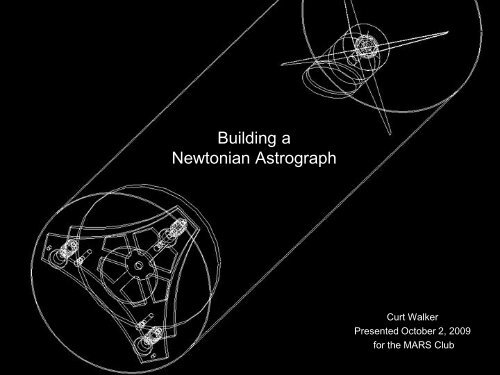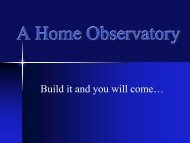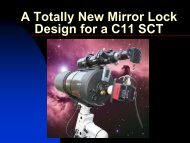Building a Newtonian Astrograph
Building a Newtonian Astrograph
Building a Newtonian Astrograph
You also want an ePaper? Increase the reach of your titles
YUMPU automatically turns print PDFs into web optimized ePapers that Google loves.
<strong>Building</strong> a<strong>Newtonian</strong> <strong>Astrograph</strong>Curt WalkerPresented October 2, 2009for the MARS Club
Topics Covered• What is an astrograph?• <strong>Building</strong> vs. Buying• Design Tools• Design Highlights• Materials & Components• Fabricating Custom Parts• Assembly• First Light & Focus Test• First Photographic Results• Finishing Touches
What is an ‘astrograph’ ?An astrograph (astrographic camera) is atelescope designed for the sole purpose ofastrophotography.Familiar forms of astrographs:- Schmidt Camera (different than Schmidt Newt)- Short FL, low F-ratio APO refractors- Ritchey-Chretien
Examples of currently mass-produced telescopesthat are (or could be) considered astrographs:Meade’s Schmidt <strong>Newtonian</strong>s
Examples of currently mass-produced telescopesthat are (or could be) considered astrographs:Vixen R200SS
Examples of currently mass-produced telescopesthat are (or could be) considered astrographs:Takahashi Epsilon 160 & 180Epsilon 160
Examples of currently mass-produced telescopesthat are (or could be) considered astrographs:Borg’s Refractor <strong>Astrograph</strong>ic Systems
Examples of currently mass-produced telescopesthat are (or could be) considered astrographs:TeleVue’s Nagler/Peztval APO Refractors
Examples of currently mass-produced telescopesthat are (or could be) considered astrographs:Various Ritchey-Chretien OTAsRC Optical Systems 16" f/8.4 CF OTARC Optical Systems 20" f/8.1 Carbon Truss
Buying vs. Rolling Your OwnReasons that influenced my decision to build:- Conversations with other ATMs- Luxury of choosing each component to suit needs/wants- Quality assurance (…ha ha)- No perfect matches with my needs/wants among commerciallymadeastrographs (all require upgrades)- My compulsive need to build stuff.
NEWT 2.5Design Tools
TurboCAD 14 DeluxeDesign Tools
Design Highlights….a telescope designed for the sole purpose of astrophotography.Needs & Wants:• 8” aperture• 1000mm focal length• Classic newtonian• Fine focusing control• Imaging first, visual second• Optical accessories(barlow or coma correction)• Minimal vignettingManifested in specs:• Thin or lightweight parabolicprimary• Motorized stepper focuser• Spacings for camera focus(extenders may be required forvisual)• Spacings with room for opticalaccessories• Fully illuminated imaging plane
Design HighlightsPlanning for a fully illuminated imager:• The focal plane is generally fully illuminated in thecenter, and gradually tapers off in brightness towardthe edge.• The 100% zone will have all of the brightness availablefrom the primary mirror.• The 75% zone is the area at the focal plane which is3/4 illuminated by the primary mirror.Source – NEWT 2.5 Help Files
Design HighlightsPlanning for a fully illuminated imager:Differing design principals for visual vs. imaging:Visual:- The larger the eyepiece field lens, the larger areas of 100% and 75%illumination required.- However, To see fine details in planetary images and faint nebulae alike,you need the maximum contrast possible.- In a newtonian telescope, one of the biggest contrast killers is anoversized diagonal mirror.- If possible, the diagonal minor axis should be kept under 20% of thediameter of the primary mirror.Source – NEWT 2.5 Help Files
Design HighlightsPlanning for a fully illuminated imager:Differing design principals for visual vs. imaging:Imaging:- To attain the brightest image possible and help avoid vignetting, theimaging plane should be as fully illuminated as possible.- This requires substantially larger secondary mirrors than in similarly sizedscopes intended for visual observing.Typically, a telescope optimized for imagingwill not perform well for visual observing.Source – NEWT 2.5 Help Files
Design HighlightsPlanning for a fully illuminated imager:100%1.194”
Design HighlightsPlanning for a fully illuminated imager:QHY8100%APS-C(DSLR)SBIGST-2000XMOrionStarShoot
Materials & ComponentsTelescope Tube – Hastings Aluminum Pipe- 10” OD, 0.064” wall- Both ends ‘rolled’- Heavy but relatively cheap and available- Variety of finishes
Materials & ComponentsSpider Vane – Protostar- Straight 4-vane- Built-in secondary offset- Internal dew heaterSecondary Mirror – Protostar- 2.60” minor axis- ULS Quartz- Interferogram says 1/14th
Materials & ComponentsFocuser – Moonlight Crayford- 3-point compression ring- Hi-Res Stepper Motor- Cercis Controller- Supports 2 focusers- Supports 2 temp probes and profiles
Materials & ComponentsPrimary – Royce Conical- 8” F/5- 3.5 lbs- Very secure mounting (no epoxy necessary)- Cools quickly
Fabrication of Custom Parts
Fabrication of Custom Parts
Fabrication of Custom Parts
Assembly
Assembly
Assembly
Assembly
First Light & Focus Test
Assembly
First Photographic ResultsM51 – Whirlpool Galaxy3x300
First Photographic ResultsNGC5139 – Omega Centauri13x120
First Photographic ResultsM8 – Lagoon Nebula12x300
Finishing Touches
Finishing Touches
What’s Next?Currently saving up for a complete imaging rig:- Mount…….GM11? Mach1GTO???- Switch to a self-guided monochrome imager(i.e. SBIG ST-2000XM or similar)- Transition to MaximDL or CCDSoft for capture andprocessing
References & Education• The Dobsonian Handbook:A Practical Manual for <strong>Building</strong> Large Aperture TelescopesBy Kriege & Berry• TurboCAD 14 Deluxe Help Files & online user forum• NEWT 2.5 Help Files• Bryan Greer of Protostar• Bob Royce of R. F. Royce Precision Optical Components• Daniel Mounsey of Woodland Hills Telescopes• Fellow ATMs across the globe via Cloudy Nights ATM Forum
Thank YouQuestions?




